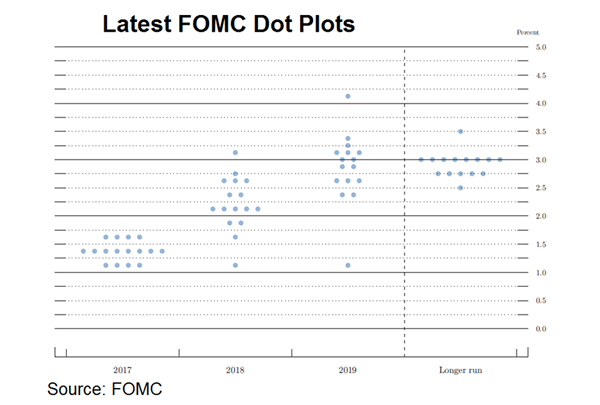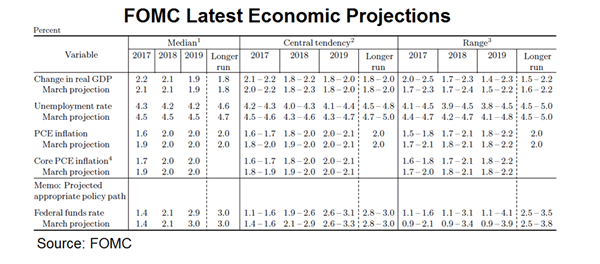We have got a more hawkish FOMC and BOE this week. For the former, policymakers raised the policy rate by +25 bps, as expected, and laid out detailed plans to unwind the balance sheet. For the latter, BOE left the Bank rate unchanged at a record low of 0.25%. Yet, the members’ division on the monetary policy widened the most in 6 years with Michael Saunders and Ian McCafferty joining Kristin Forbes in support of a rate hike of +25 bps. The tug of war on interest rate differential results in higher volatility in GBPUSD. After BOE’s announcement, GBPUSD erased earlier loss from an intra-day low of 1.2688 and rallied to 1.2795, before retreating again. The selloff of EURGBP widened with the pair plunging to a one-week low of 0.8721. ECB earlier this month refrained from talking about tapering and reaffirmed that it would extend QE purchases, if necessary.
FOMC
As widely anticipated, FOME raised the Fed funds rate by +25 bps to 1-1.25%. The latest median dot plot continues to signal one more rate hike 2017. This is followed by three hikes in both 2018 and 2019. On the economic projections, the staff upgraded the GDP growth outlook to +2.2% from +2.1% previously. The staff, however, revised lower the core PCE to +1.7% in 2017, but left those for 2018 and 2019 unchanged at +2%. Meanwhile, the unemployment rate was revised lower to 4.3% in 2017 and 4.2% in 2018-19. The long-run unemployment rate was revised down, by one-tenth, to 4.6%.
What caught the most attention was the release of an addendum to the ‘Policy Normalization Principles and Plans’ which provides guidelines on the process of balance sheet normalization. The Fed indicated that the process would begin this year ‘provided that the economy evolves broadly as expected’. To our, and most market participants’, surprise, policymakers have discussed the arrangement, including start size, timing, and the rate of increase and limit) in great details. Initial caps were set at US$ 6B per month for Treasuries and US$ 4B per month for mortgages, increasing in steps of US$ 6B and US$ 4B respectively for Treasuries and mortgages every three months, until the caps reach US$ 30B and US$ 20B, respectively. The Fed expects that, after reaching the maximum runoff rate, ‘holdings will continue to decline in a gradual and predictable manner until the Fed judges that the central bank is holding no more securities than necessary to implement monetary policy efficiently and effectively’. The Fed also added that it would be prepared to resume reinvestment of principal payments ‘if a material deterioration in the economic outlook were to warrant a sizable reduction in the Committee’s target for the federal funds rate’. We expect a formal announcement of the plan would be made in September, followed by implementation in October. We believe the economic developments have to deteriorate very significantly to alter the Fed’s plan


BOE
As expected, BOE left its Bank rate unchanged at 0.25% in June, at a 5-3 vote. Michael Saunders and Ian McCafferty joined Kristin Forbes in voting for an immediate interest rate rise to fight against rising inflation. the central bank unanimously decided to leave the bond purchase program at 435B pound for UK gilts and 10B pound for non-financial GBP investment-grade corporate bonds. Concerns over rising inflation were evidence in the minutes. Policymakers acknowledged that CPI inflation has been ‘pushed above the 2% target by the impact of last year’s sterling depreciation’. It ‘reached 2.9% in May, above the MPC’s expectation’. Policymakers noted that ‘inflation could rise above 3% by the autumn, and is likely to remain above the target for an extended period as sterling’s depreciation continues to feed through into the prices of consumer goods and services’. The members also raised concerns over currency depreciation on inflation. They noted that ‘2.5% fall in the exchange rate since the May Inflation Report, if sustained, will add to that imported inflationary impetus’.
Sterling rallied against US dollar and the euro shortly after the announcement. Rate hike speculations heightened as three members, compared with one previously, voted for a 25bp rate increase. Meanwhile, the statement mentioned that ‘the continued growth of employment could suggest that spare capacity is being eroded, lessening the trade-off that the MPC is required to balance and, all else equal, reducing the MPC’s tolerance for above-target inflation’.
Despite heightened expectations, we expect the central bank to leave the interest rates unchanged for the rest of the year. Conservatives’ loss of majority in the general election and the hung parliament have increased uncertainty in the Brexit negotiations between the UK and the EU. Policymakers would have to be more cautious in their moves.












